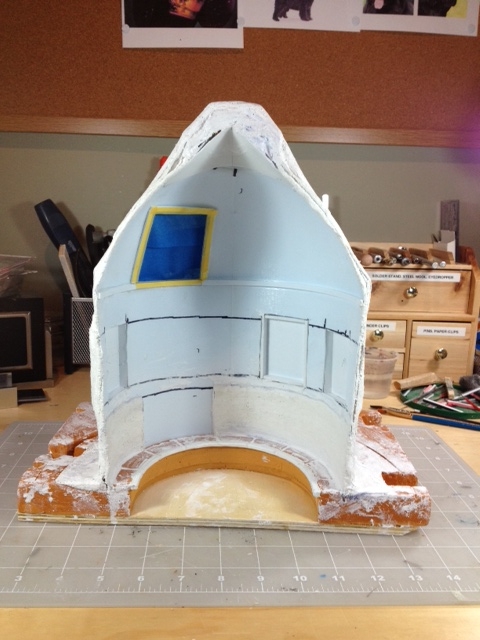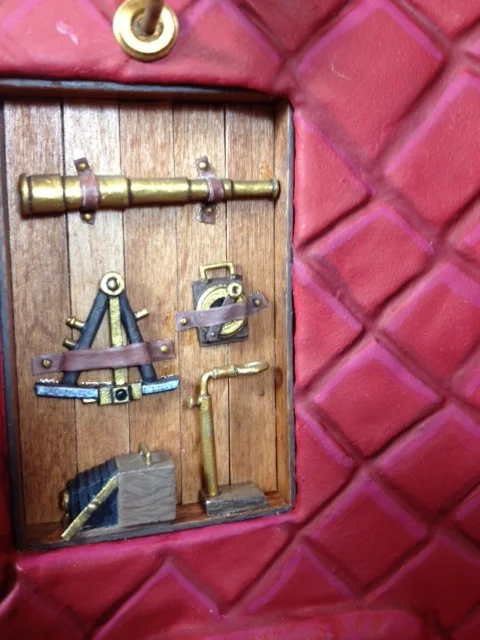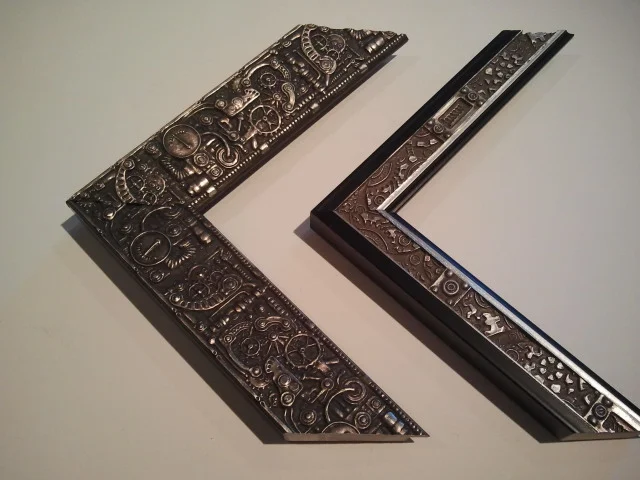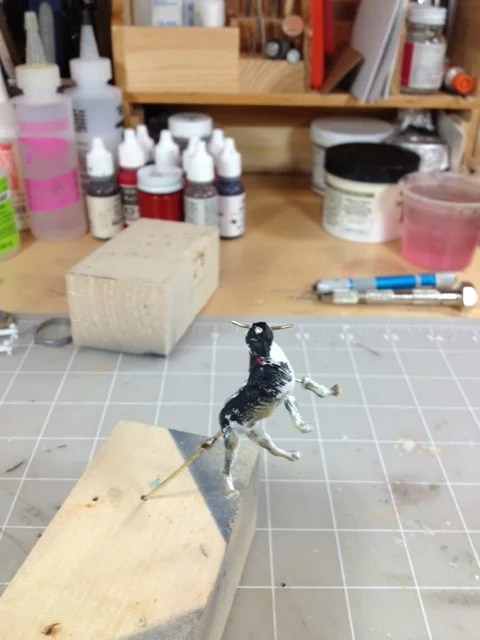Step by Step: From the Earth to the Moon
By Jim DeRogatis
Research is important and inspiring, even for a fantasy scene. Though it was far less intense on this project than it had been for “The Spoils of War,” I nevertheless spent hours scouring the Web and books for images from Verne’s two novels about this voyage to the moon, as well as other esoteric things like pictures of dogs, Victorian gas lights, sofa cushions, fabrics, clothing, hair styles, and more. I wanted a fanciful “steampunk” look, but I didn’t want to stray too far from the historical realities of the era, in part because Verne’s charm is that he always remained within the realm of the possible.
Above are a few illustrations I found particularly inspiring, and a shot of the bulletin board over my modeling desk crammed with various images.
The biggest dilemma for this box was scratchbuilding the bullet/space projectile. After a lot of brainstorming with the usual MMSI weekly breakfast crew, I seized upon on the idea of trying a gallon bleach bottle to at least provide the basic shape, which I could then alter with plaster-coated strips of the sort model railroaders use to build hills and mountains. Here is the bottle I started with; I decided to build the scenery for this diorama first, because I knew that if the capsule didn’t look right, there would be no point in continuing. Once I knew the bottle would work, I also went ahead and built the outer box. I usually use a temporary foamcore box through most of the project, building the outer box last, but since the dimensions of the capsule would be set, I flipped the script this time around.
The cut-away bleach bottle needed some support, so I set it in a thick piece of balsa foam glued to a piece of plywood to make it rigid; the balsa foam also provided the seat of the couch running around the capsule. The seat back and tufting lining the capsule were sculpted from the usual Aves/Duro mix—hence all of the green in the photo before priming.
I had a lot of fun scratching the various Victorian instruments stowed in the storage cabinets and the dials on the wall, all in 75mm, which I’d hit on as the perfect scale based on the size of that bleach bottle and playing around with different size figures from the scrap box to see what looked right. The shovel, pick and rifles are the only stock accessories; everything else is wire, putty, and bits of sheet plastic or styrene strip. I was particularly proud of the scratched umbrella; no self-respecting Victorian gent would ever leave home without one, much less head to the moon empty-handed!
For the gas lamps, the bases came from pieces of a dollhouse chandelier cut apart with a razor saw and drilled out to accept a micro-LED chip and wiring. They were topped with clear dollhouse drinking glasses that were just the right size and perfectly tapered to do the job.
Here are a few more looks at the capsule nearing completion. The last shot shows it fixed to the angle I wanted for the finished display, helping to convey motion. One goal with this scene in a tightly confined but tall space was to have a lot of interest at different levels. After building the wood floor (and the drawers under the sofa), I decided I needed a hatch to the lower level from whence would spring the chickens our intrepid explorers brought aboard to provide breakfast—and eventually dinner—on the moon (they’re in the book, and so is a fair amount of discussion about the dogs). I drilled the hole for the hatch, added the ladder, and used an electrical box metal part for the fixture, as seen in the middle photo.
Early lighting tests: The stars are various size fiber optic strands; the moon I sculpted from Aves on a round disc set in the black-velvet backdrop along with the stars and illuminated by a single cool white LED. Around this time I also went to my framing guy at my favorite shop, April 7’s, to order a frame for the exterior. He had just gotten two steampunk frames in stock, and I knew they would fit this project perfectly.
The human figures in this diorama were sculpted almost entirely from scratch, with converted 75mm Michael Roberts heads, hands, and shoe blanks. Here are the wire limbs and my cast resin torsos and pelvises.
I took a lot of time playing with the positioning to get the animation right before beginning to work fleshing the figures out with Aves Apoxy Sculpt and finishing the clothing with my usual mixture of Aves/Duro. In some cases, I used a bit of sheet lead for collars, cuffs, and coattails, to give me a surface to sculpt against. The dogs and chickens are heavily converted 1/24th scale Preiser animals.)
As a tribute to Verne, I tried to capture his likeness for this figure, who of course I depicted as excitedly taking notes.
Following are some shots of the painting in progress.
Joe Berton gave me the idea of creating a title card in the form of a Victorian-era book cover. I used an image of an early edition of From the Earth to the Moon as the starting point, added the famous image of the Man in the Moon with a bullet in his eye from the classic film A Trip to the Moon by Georges Méliès, and played with the color and added some additional text in PhotoShop.
Finally, some additional shots of the finished diorama. The first is by Bob Sarnowski of the MMSI; the rest I shot at home with my Nikon (in contrast to the images above, which were all quick-and-dirty with the iPhone!). I am proud to say that the box won a Gold Medal at the 2012 MMSI Chicago Show, and that it now belongs to MMSI member Dan Bird.










































